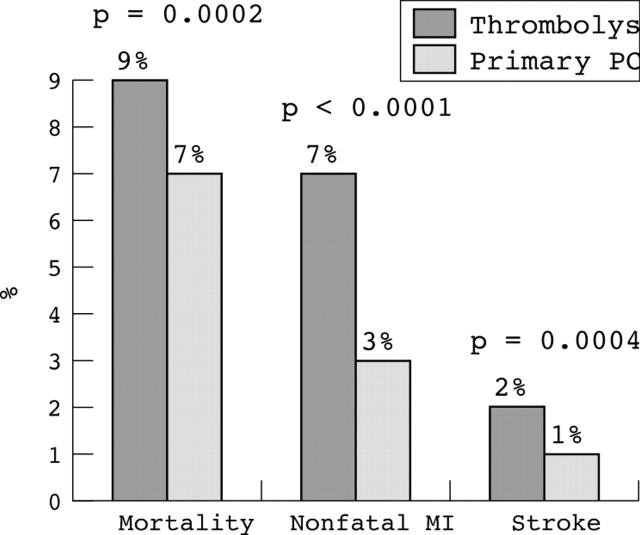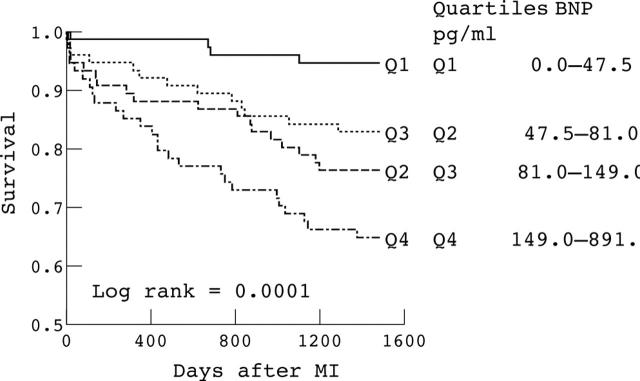Abstract
In most patients with heart failure due to left ventricular systolic dysfunction, the underlying cause is coronary heart disease. To reduce progression to heart failure in a patient with acute myocardial infarction, it is important to achieve the earliest possible reperfusion, whether by thrombolysis or primary percutaneous coronary intervention. Every patient with acute myocardial infarction should have an assessment of their left ventricular function, the potential for reversibility should be considered, and reversible ischaemia should be identified. Left ventricular dysfunction does not only occur with ST segment elevation myocardial infarction but is also commonly associated with non-ST segment elevation myocardial infarction. Secondary prevention is crucial and this requires long term commitment by the patient and the health care system. Heart failure and left ventricular dysfunction are treatable but require a multidisciplinary, integrated network approach.
Full Text
The Full Text of this article is available as a PDF (93.1 KB).
Figure 1.
Comparison of short term end points after primary PCI and thrombolysis reperfusion treatment for acute myocardial infarction, from a review of 23 trials. Adapted with permission from Keeley et al.2
Figure 2.
Data from a consecutive series of patients with myocardial infarction, showing how total mortality is associated with BNP concentration (pg/ml).
Figure 3.
Magnetic resonance imaging scan showing a myocardial infarction—this was a "silent" infarction as the patient had experienced no chest pain.
Selected References
These references are in PubMed. This may not be the complete list of references from this article.
- Abraham William T., Fisher Westby G., Smith Andrew L., Delurgio David B., Leon Angel R., Loh Evan, Kocovic Dusan Z., Packer Milton, Clavell Alfredo L., Hayes David L. Cardiac resynchronization in chronic heart failure. N Engl J Med. 2002 Jun 13;346(24):1845–1853. doi: 10.1056/NEJMoa013168. [DOI] [PubMed] [Google Scholar]
- Boersma E., Maas A. C., Deckers J. W., Simoons M. L. Early thrombolytic treatment in acute myocardial infarction: reappraisal of the golden hour. Lancet. 1996 Sep 21;348(9030):771–775. doi: 10.1016/S0140-6736(96)02514-7. [DOI] [PubMed] [Google Scholar]
- Bristow Michael R., Saxon Leslie A., Boehmer John, Krueger Steven, Kass David A., De Marco Teresa, Carson Peter, DiCarlo Lorenzo, DeMets David, White Bill G. Cardiac-resynchronization therapy with or without an implantable defibrillator in advanced chronic heart failure. N Engl J Med. 2004 May 20;350(21):2140–2150. doi: 10.1056/NEJMoa032423. [DOI] [PubMed] [Google Scholar]
- Cleland J. G., Daubert J. C., Erdmann E., Freemantle N., Gras D., Kappenberger L., Klein W., Tavazzi L., CARE-HF study Steering Committee and Investigators The CARE-HF study (CArdiac REsynchronisation in Heart Failure study): rationale, design and end-points. Eur J Heart Fail. 2001 Aug;3(4):481–489. doi: 10.1016/s1388-9842(01)00176-3. [DOI] [PubMed] [Google Scholar]
- Jernberg Tomas, James Stefan, Lindahl Bertil, Johnston Nina, Stridsberg Mats, Venge Per, Wallentin Lars. Natriuretic peptides in unstable coronary artery disease. Eur Heart J. 2004 Sep;25(17):1486–1493. doi: 10.1016/j.ehj.2004.06.017. [DOI] [PubMed] [Google Scholar]
- Keeley Ellen C., Boura Judith A., Grines Cindy L. Primary angioplasty versus intravenous thrombolytic therapy for acute myocardial infarction: a quantitative review of 23 randomised trials. Lancet. 2003 Jan 4;361(9351):13–20. doi: 10.1016/S0140-6736(03)12113-7. [DOI] [PubMed] [Google Scholar]
- Linde Cecilia, Leclercq Christophe, Rex Steve, Garrigue Stephane, Lavergne Thomas, Cazeau Serge, McKenna William, Fitzgerald Melissa, Deharo Jean-Claude, Alonso Christine. Long-term benefits of biventricular pacing in congestive heart failure: results from the MUltisite STimulation in cardiomyopathy (MUSTIC) study. J Am Coll Cardiol. 2002 Jul 3;40(1):111–118. doi: 10.1016/s0735-1097(02)01932-0. [DOI] [PubMed] [Google Scholar]
- MacIntyre K., Stewart S., Capewell S., Chalmers J. W., Pell J. P., Boyd J., Finlayson A., Redpath A., Gilmour H., McMurray J. J. Gender and survival: a population-based study of 201,114 men and women following a first acute myocardial infarction. J Am Coll Cardiol. 2001 Sep;38(3):729–735. doi: 10.1016/s0735-1097(01)01465-6. [DOI] [PubMed] [Google Scholar]
- Morrow D. A., Cannon C. P., Rifai N., Frey M. J., Vicari R., Lakkis N., Robertson D. H., Hille D. A., DeLucca P. T., DiBattiste P. M. Ability of minor elevations of troponins I and T to predict benefit from an early invasive strategy in patients with unstable angina and non-ST elevation myocardial infarction: results from a randomized trial. JAMA. 2001 Nov 21;286(19):2405–2412. doi: 10.1001/jama.286.19.2405. [DOI] [PubMed] [Google Scholar]
- Moss Arthur J., Zareba Wojciech, Hall W. Jackson, Klein Helmut, Wilber David J., Cannom David S., Daubert James P., Higgins Steven L., Brown Mary W., Andrews Mark L. Prophylactic implantation of a defibrillator in patients with myocardial infarction and reduced ejection fraction. N Engl J Med. 2002 Mar 19;346(12):877–883. doi: 10.1056/NEJMoa013474. [DOI] [PubMed] [Google Scholar]
- Rawles J., GREAT GREAT: 10 year survival of patients with suspected acute myocardial infarction in a randomised comparison of prehospital and hospital thrombolysis. Heart. 2003 May;89(5):563–564. doi: 10.1136/heart.89.5.563. [DOI] [PMC free article] [PubMed] [Google Scholar]
- Rose E. A., Gelijns A. C., Moskowitz A. J., Heitjan D. F., Stevenson L. W., Dembitsky W., Long J. W., Ascheim D. D., Tierney A. R., Levitan R. G. Long-term use of a left ventricular assist device for end-stage heart failure. N Engl J Med. 2001 Nov 15;345(20):1435–1443. doi: 10.1056/NEJMoa012175. [DOI] [PubMed] [Google Scholar]
- Yusuf Salim, Hawken Steven, Ounpuu Stephanie, Dans Tony, Avezum Alvaro, Lanas Fernando, McQueen Matthew, Budaj Andrzej, Pais Prem, Varigos John. Effect of potentially modifiable risk factors associated with myocardial infarction in 52 countries (the INTERHEART study): case-control study. Lancet. 2004 Sep 11;364(9438):937–952. doi: 10.1016/S0140-6736(04)17018-9. [DOI] [PubMed] [Google Scholar]





